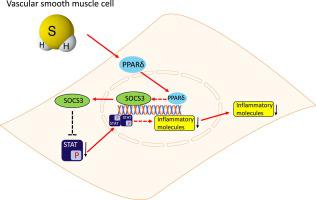Journal of Advanced Research ( IF 10.7 ) Pub Date : 2020-06-20 , DOI: 10.1016/j.jare.2020.06.005 Danyang Tian 1 , Xu Teng 1 , Sheng Jin 1 , Yuhong Chen 1, 2 , Hongmei Xue 1 , Lin Xiao 1 , Yuming Wu 1, 3

|
Introduction
Mounting evidences demonstrated the deficiency of hydrogen sulfide (H2S) facilitated the progression of cardiovascular diseases. However, the exact effects of H2S on vascular remodeling are not consistent.
Objectives
This study aimed to investigate the beneficial role of endogenous H2S on vascular remodeling.
Methods
CSE inhibitor, DL-propargylglycine (PPG) was used to treat mice and vascular smooth muscle cells (VSMCs). Sodium hydrosulfide (NaHS) was given to provide hydrogen sulfide. Vascular tension, H&E staining, masson trichrome staining, western blot and CCK8 were used to determine the vascular remodeling, expressions of inflammatory molecules and proliferation of VSMCs.
Results
The deficiency of endogenous H2S generated vascular remodeling with aggravated active and passive contraction, thicken aortic walls, collagen deposition, increased phosphorylation of STAT3, decreased production of PPARδ and SOCS3 in aortas, which were reversed by NaHS. PPG inhibited expression of PPARδ and SOCS3, stimulated the phosphorylation of STAT3, increased inflammatory molecules production and proliferation rate of VSMCs which could all be corrected by NaHS supply. PPARδ agonist GW501516 offered protections similar to NaHS in PPG treated VSMCs. Aggravated active and passive contraction in PPG mice aortas, upregulated p-STAT3 and inflammatory molecules, downregulated SOCS3 and phenotype transformation in PPG treated VSMCs could be corrected by PPARδ agonist GW501516 treatment. On the contrary, PPARδ antagonist GSK0660 exhibited opposite effects on vascular contraction in aortas, expressions of p-STAT3 and SOCS3 in VSMCs compared with GW501516.
Conclusion
In a word, endogenous H2S protected against vascular remodeling through preserving PPARδ/SOCS3 anti-inflammatory signaling pathway. Deficiency of endogenous H2S should be considered as a risk factor for VSMCs dysfunction
中文翻译:

内源性硫化氢通过 PPARδ/SOCS3 信号传导改善血管重塑
介绍
越来越多的证据表明硫化氢(H 2 S)的缺乏促进了心血管疾病的进展。然而,H 2 S 对血管重塑的确切影响并不一致。
目标
本研究旨在探讨内源性H 2 S 对血管重塑的有益作用。
方法
CSE 抑制剂 DL-炔丙基甘氨酸 (PPG) 用于治疗小鼠和血管平滑肌细胞 (VSMC)。给予氢硫化钠 (NaHS) 以提供硫化氢。血管张力、H&E染色、masson三色染色、western blot和CCK8检测血管重构、炎症分子表达和VSMCs增殖情况。
结果
内源性H 2缺乏症S 产生血管重塑,主动和被动收缩加重,主动脉壁增厚,胶原沉积,STAT3 磷酸化增加,主动脉中 PPARδ 和 SOCS3 的产生减少,这些被 NaHS 逆转。PPG 抑制 PPARδ 和 SOCS3 的表达,刺激 STAT3 的磷酸化,增加炎症分子的产生和 VSMC 的增殖率,这些都可以通过 NaHS 供应来纠正。PPARδ 激动剂 GW501516 在 PPG 处理的 VSMC 中提供类似于 NaHS 的保护。PPG 小鼠主动脉中加重的主动和被动收缩、上调的 p-STAT3 和炎症分子、下调的 SOCS3 和 PPG 处理的 VSMC 中的表型转化可以通过 PPARδ 激动剂 GW501516 治疗得到纠正。相反,
结论
总之,内源性H 2 S通过保留PPARδ/SOCS3抗炎信号通路来防止血管重塑。内源性 H 2 S缺乏应被视为 VSMC 功能障碍的危险因素


























 京公网安备 11010802027423号
京公网安备 11010802027423号